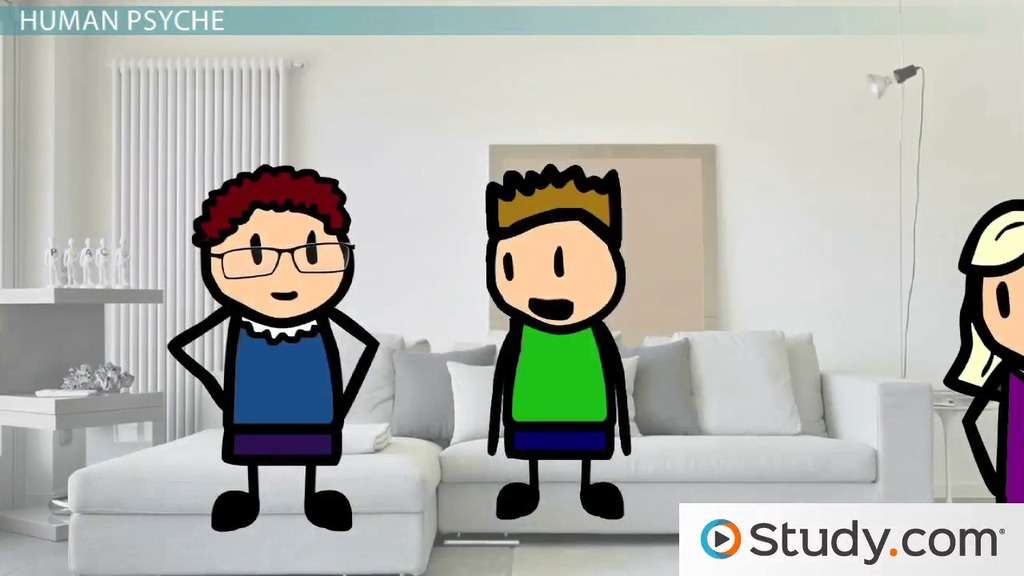Personality Theory
In his theory of personality, Carl Jung distinguishes two different attitude types: Introverts, which are those people who receive stimulation from within, and extroverts, which are those who receive their stimulation from the environment.
Introverts can be perceived as withdrawn or shy, but they are more defined as those who get their energy from being alone and being able to recharge through less stimulating activities, whereas extroverts get their energy from being around other people and engaging in stimulating activities. For example, Donna is an extrovert. She loves to go out on adventures with lots of people and see exciting new things. Her friend David, though, is the opposite. Given the choice, he’d rather read a book on his couch than go skydiving with Donna. David is an introvert.
Jung also separates introverts and extroverts into four subtypes according to the functions that control the way they perceive the world. Both introverts and extroverts can be any of these subtypes, so there are eight possible personality types. These four functions are:
1. Thinking
Applying reasoning to the situations and environments you encounter. For example, David likes to think things through and consider all the pros and cons before he makes a decision about anything.
2. Feeling
Applying subjective, personal assessment to the situations and environments you encounter. Unlike David, Donna relies on her feelings to tell her how to make a decision. If something feels good, she goes for it; if it doesn’t, she avoids it.
3. Sensation
Applying aesthetic value to the situations and environments you encounter. For example, when deciding how to arrange his living room, David tries to make things very symmetrical. If there’s a chair on one side of the room, he has to put the same chair on the other side of the room to balance it. This symmetry makes the room look nice.
4. Intuition
Using your unconscious or the mystical to understand your experiences. For example, Donna thinks David is arranging his furniture all wrong. Donna believes it is important to arrange furniture more spaced apart in order to bring about positive energy.
Human Psyche
The human psyche is the whole mind, including the conscious and the unconscious. Jung’s theory states that each person’s psyche is comprised of three components:
1. Ego
The hub of consciousness that forms all unrepressed perceptions, thoughts, feelings and memories. When Donna walks into a room, her ego perceives the color of the walls, the people in the room and what they’re doing and the song playing in the background. But, the ego can only hold a select amount of information and the remaining data sinks into the unconscious.
2. Personal unconscious
The experiences and memories unique to the individual that are not currently in, but are readily available to, the conscious mind. For example, maybe Donna feels uncomfortable in the room where she just walked. She doesn’t like it, but she’s not sure why. It just gives her a bad feeling. Perhaps it’s because the walls are the same color as the hospital room where her grandmother died. She doesn’t consciously associate the room with her grandmother dying, but she has bad feelings because her personal unconscious is at work.
3. Collective unconscious
The universal experiences and memories shared by all humans – the blueprints for life that allow us to adapt and survive. The collective unconscious is further comprised of archetypes, or modes of thought that belong to all of humanity. The hero and villain, son and father, strong and weak – these are all archetypes. Donna also feels uneasy in the room because the decorations are almost all red. She associates red with anger and aggression, and blue with serenity and peace, like many people do. This is an example of archetypes.
Dream Analysis
It was during his research into dream analysis that Jung parted ways with Freud; he disagreed with Freud’s heavy emphasis on sexual motivation in dreams. Additionally, Freud believed that the unconscious mind used dreams to hide repressed desires from the conscious, whereas Jung believed that the unconscious mind used dreams to reveal suppressed desires to the conscious.
According to Jung’s theory, as a window to the unconscious, dreams serve to help you solve problems in your waking life and become a more whole person. Dreams are formed by the two parts of the unconscious – the personal and the collective. They can be analyzed by interpreting the archetypes presented by the collective unconscious; however, the symbolism contained in dreams is specific to the individual’s life. Therefore, meaning cannot be broadly ascribed to a symbol. For example, a dream about falling might mean one person’s career is on the wrong track, while the same dream might signify repressed sexual desires for another person.
Lesson Summary
Jungian psychology, also called analytical psychology, is a branch of psychology founded by Carl Jung. He studied personalities and clustered people into introverts and extroverts. Further, he said that introverts and extroverts could view the world through thinking, feeling, sensation or intuition. Jung believed that the human psyche had three parts: the ego, personal unconscious and collective unconscious. Finally, his dream analysis was broader than Freud’s, as Jung believed that symbols could mean different things to different people.
Learning Outcomes
Upon completion of this lesson, you should be able to:
- Understand Carl Jung’s contributions to psychology
- Differentiate between introverts and extroverts
- Name and summarize the four personality subtypes and the three components of the human psyche
- Explain Jung’s dream analysis and how it differed from Freud’s
Have you ever felt like you learn best in a particular way? Learning styles affect how well we learn under certain conditions. Some students learn best by hearing information, while others learn best by seeing it. Different theories have emerged to describe how students prefer to learn best, including Jungian learning styles, the VARK learning style model, and the Kolb learning style model.
Jungian Learning Styles
:max_bytes(150000):strip_icc()/478167739-56a794185f9b58b7d0ebdc85.jpg)
Sam Edwards / Caiaimage / Getty Images
One learning style theory is based on the work of analytical psychologist Carl Jung, who developed a theory of psychological types designed to categorize people in terms of various personality patterns.
Jung’s Theory of Personality Types
Jung’s theory focuses on four basic psychological functions:
- Extraversion vs. introversion
- Sensation vs. intuition
- Thinking vs. feeling
- Judging vs. perceiving
This theory later led to the development of the famous Myers-Briggs Type Indicator.
These dimensions can also be used to assess and describe various learning styles. While each dimension represents a unique aspect of a learning style, individual learning style may include a combination of these dimensions. For example, your learning style might include elements of extraverted, sensing, feeling, and perceiving learning styles.
Extraverted Learning Style
:max_bytes(150000):strip_icc()/468838813-56a0e96c5f9b58eba4b51977.jpg)
Tom Merton / Caiaimage / Getty Images
The first component of the Jungian learning style dimensions indicates how learners interact with the outside world. Extraverted learners enjoy generating energy and ideas from other people. They prefer socializing and working in groups. Learning activities that benefit extraverted learners include teaching others how to solve a problem, collaborative work, and problem-based learning.
If you enjoy teaching others, participating in a group, and learning by experience, you are probably an extraverted learner. Approximately 60% of learners are extraverted learners.
Characteristics of Extravert Learners
- Learn best through direct experience
- Enjoy working with others in groups
- Often gather ideas from outside sources
- Willing to lead, participate and offer opinions
- Jump right in without guidance from others
Introverted Learning Style
:max_bytes(150000):strip_icc()/530682799-56a0e83c3df78cafdaa6432b.jpg)
Dan Schaffer / Caiaimage / Getty Images
While introverted learners are still sociable, they prefer to solve problems on their own. Introverted learners enjoy generating energy and ideas from internal sources, such as brainstorming, personal reflection, and theoretical exploration.
These learners prefer to think about things before attempting to try a new skill. If you enjoy solitary studying, individual work, and abstract ideas, you are probably an introverted learner. Approximately 40% of learners are introverted learners.
Characteristics of Introvert Learners
- Prefer to work alone
- Enjoy quiet, solitary work
- Often generate ideas from internal sources
- Prefer to listen, watch and reflect
- Like to observe others before attempting a new skill
Sensing Learning Style
:max_bytes(150000):strip_icc()/457992307-56a0e92b3df78cafdaa64d5f.jpg)
Matt Lincoln / Cultura Exclusive / Getty Images
Sensing learners are focused on aspects of the physical environment. Jung described these individuals as being interested in the external world. They tend to be realistic and practical, preferring to rely on information gained through experience.
While people with a sensing learning style enjoy order and routine, they also tend to be very quick to adapt to changing environments and situations. Approximately 65% of learners have a sensing learning style.
Characteristics of Sensate Learners
- Focus on the present
- Practical and reasonable
- Use experience and common sense to solve problems
- Keenly observe the surrounding world
Intuitive Learning Style
:max_bytes(150000):strip_icc()/173975135-56a0e9c03df78cafdaa65330.jpg)
Tim Robberts / Taxi / Getty Images
Intuitive learners tend to focus more on the world of possibility. Unlike sensing learners, who are interested in the here and now, intuitive learners enjoy considering ideas, possibilities, and potential outcomes. These learners like abstract thinking, daydreaming, and imagining the future. Approximately 35% of learners are intuitive learners.
Characteristics of Intuitive Learners
- Prefer to work in short sessions, rather than finishing a task all at once
- Enjoy new challenges, experiences, and situations
- More likely to look at the big picture rather than the details
- Like theories and abstract ideas
Thinking Learning Style
:max_bytes(150000):strip_icc()/525467323-56a794b05f9b58b7d0ebe29b.jpg)
Westend61 / Getty Images
Individuals with a thinking learning style tend to focus more on the structure and function of information and objects. Thinking learners use rationality and logic when dealing with problems and decisions. These learners often base decisions on personal ideas of right, wrong, fairness, and justice. Approximately 55% of males and 35% of females have a thinking learning style.
Characteristics of Thinking Learners
- Interested in logic and patterns
- Dislike basing decisions on emotions
- Make decisions based on reason and logic
Feeling Learning Style
:max_bytes(150000):strip_icc()/485207255-56a0ea113df78cafdaa65714.jpg)
Tim Robberts / Taxi / Getty Images
People with a feeling style manage information based on the initial emotions it generates. They are interested in personal relationships, feelings, and social harmony. If you base decisions on emotions and dislike conflict, you might have a feeling learning style. Approximately 45% of males and 65% of females are feeling learners.
Characteristics of Feeling Learners
- Interested in people and their feelings
- In tune with their own emotions and those of other people
- Base decisions on immediate feelings
- Generate excitement and enthusiasm in group settings
Judging Learning Style
:max_bytes(150000):strip_icc()/GettyImages-492334609-56a797273df78cf7729769fd.jpg)
Peopleimages.com / DigitalVision / Getty Images
Judging learners tend to be very decisive. In some cases, these learners may make decisions too quickly, before learning everything they need to know about a situation. These learners prefer order and structure, which is why they tend to plan out activities and schedules very carefully.
If you are highly organized, detail-oriented, and have strong opinions, you might be a judging learner. Approximately 45% of people are judging learners.
Characteristics of Judging Learners
- Do not like ambiguity or mystery
- Tend to be firm in their decisions
- Very organized and structured
- Have strong opinions
- Generally follow the rules
Perceiving Learning Style
:max_bytes(150000):strip_icc()/169261202-56a0edfe5f9b58eba4b54a69.jpg)
Hill Street Studios / Blend Images / Getty Images
Perceiving learners tend to make decisions impulsively in response to new information and changing situations. However, these learners tend to focus more on indulging their curiosity rather than making decisions. Unlike judging learners who tend not to change their minds, perceiving learners prefer to keep their options open.
If you tend to start many projects at once (often without finishing any of them), avoid strict schedules, and jump into projects without planning, you might be a perceiving learner. Approximately 55% of people are perceiving learners.
Characteristics of Perceiving Learners
- Often make impulsive decisions
- Change decisions based on new information
- Dislike structure and organization
- Tend to be very flexible and adaptable
- Sometimes have trouble making decisions
Can You Change Your Learning Style?
No matter how you feel about how you learn best, branching out and trying other learning strategies can help maximize learning. Sticking to what you believe is your preferred style may not help you get the most out of your study time.
One study found that learning styles can change for a variety of reasons. Factors that can contribute to changes in learning styles include:
- Context
- Environment
- Teaching method
- Subject matter
How to Change Your Learning Style
So if you want to work on changing your preferred learning style, try changing where you study and experiment with different learning methods. Intentionally incorporate other tactics and learning formats—such as videos, visuals, lectures, readings, and group discussions—into your studies.
While the concept of learning styles has become very popular, it has also been the subject of considerable criticism. Labeling students with one specific style, critics suggest, can hinder the learning process.
Research has also demonstrated that matching instructional strategies to student learning styles does not improve educational outcomes. So while you might feel like a certain style matches your learning preferences, drawing on various learning and study strategies is the best way to ensure you get the most out of your educational experience.
Different approaches can also help improve your capacity for learning and challenge your brain to tackle different challenges. So if you know that you prefer to learn by quietly reading on your own, you might augment your solo studies by participating in a study group where you can further cement that knowledge (and pick up other new information) through group discussions or guest lectures.
Varying your approach to learning can not only help introduce you to new study strategies, but can also help make learning more fun and interesting.
A Word From Verywell
The learning styles based on Jung’s theory of personality represent just one way of thinking about how people learn. While the concept of learning styles remains very popular, research has found little evidence to support the idea that offering instruction based upon learning preferences leads to improved learning outcomes.
But learning styles can still be a helpful way to think about some of the ways that you enjoy learning. As you look at each style, think about which strategies appeal the most to you. In all likelihood, you will find that your own unique learning preferences draw upon several learning styles.



